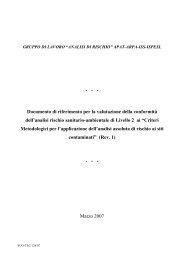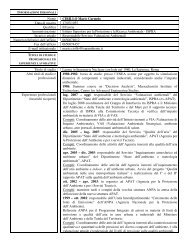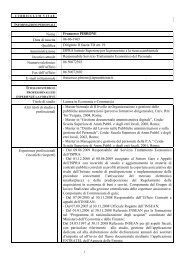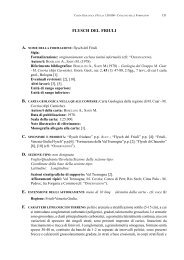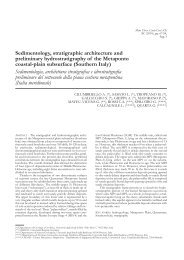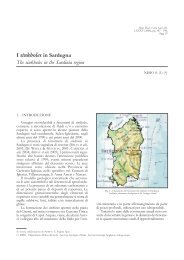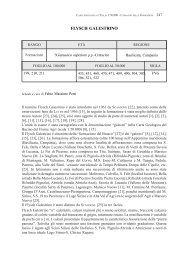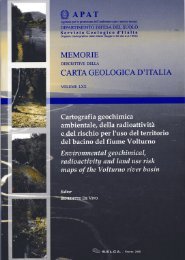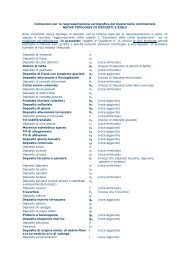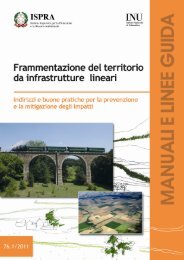Guidebook - Ispra
Guidebook - Ispra
Guidebook - Ispra
You also want an ePaper? Increase the reach of your titles
YUMPU automatically turns print PDFs into web optimized ePapers that Google loves.
Volume n° 1 - from PR01 to B15<br />
B12<br />
B12 -<br />
Leader: M. Sandulescu<br />
Figure 5 - Synthetic cross - section through the East<br />
Carpathians (in central Moldavia) (acc. to Săndulescu,<br />
Stănică and Visarion in Săndulescu , 1994). B -<br />
Bucovinian Nappe, SB - Subbucovinian Nappe, IB<br />
- Infrabucovinian Nappe, FN - Black Flysch Nappe, CH<br />
- Ceahlău Nappe, FC - Convolute Flysch Nappe, M -<br />
Macla Nappe, A - Audia Nappe, TC - Tarcău Nappe, MA<br />
- Marginal Folds Nappe, SC - Subcarpathians Nappe,<br />
Cr - crystalline formations, Pz - 3 - Upper Paleozoic, Mz<br />
- Mesozoic, N - Neogene, Th - Tithonian, k 1 - Lower<br />
Cretaceous, k 2 - Upper Cretaceous, Pg 1 - Paleocene, Pg<br />
2 - Eocene, o 1 - Oligocene, m 1 - Lower Miocene, m 2<br />
- Middle Miocene.<br />
cross lamination can sometimes be observed.<br />
Next, a shaly-calcareous flysch formation consisting<br />
of calcareous sandstones, calcarenites and calcirudites<br />
with intercalations of greenish-grey shales follows<br />
conformably. In the graded calcarenites elements of<br />
mafic rocks and of Neojurassic limestones can be<br />
observed. The Aptian age of this formation was demonstrated<br />
by Brachiopods (Belbeckella gibbsiana),<br />
Orbitolinids and a palynological association.<br />
The sequence continues with the Soharu Formation,<br />
which could be characterized as a grey argillaceous<br />
flysch with Wildflysch episodes. It consists of siltstones<br />
and weakly calcareous sandstones, dark clays,<br />
calcirudites and conglomerates with pebbles of mafic<br />
rocks and limestones.<br />
Micropaleontological evidence as well as Ammonites<br />
limit the age as Upper Aptian-Lower Albian.<br />
A grey Lower Albian Wildflysch Formation with<br />
olistoliths of Upper Jurassic massive limestones and<br />
mafic rocks represents a lateral facies variation of<br />
the Soharu Formation. Besides the chaotic blocks of<br />
calcirudites, calcarenites, polymictic conglomerates,<br />
basic tuffs or jaspers, a paratypic flyschoid facies<br />
also occurs.<br />
The Upper Albian is represented by the Pârâul Izvorului<br />
Formation. It consists of a grey flysch with evident<br />
graded bedding and convolute structure, the main<br />
rock types being micaceous sandstones and marls.<br />
The constraining macro-and micropaleontological<br />
data were found in the same formation occurring in<br />
another structural unit (the Curechiu Nappe).<br />
At its upper part, the Pârâul Izvorului Formation passes<br />
into the ortho-quartzitic Negrileasa Conglomerates<br />
(Cenomanian).<br />
The Senonian of the Bucium Unit overlies transgressively<br />
the previously described formations as well<br />
as the crystalline schists of the Northern Apuseni<br />
Mountains. It starts with a Upper Santonian Gosau<br />
Formation (rudist-bearing limestones) followed by



